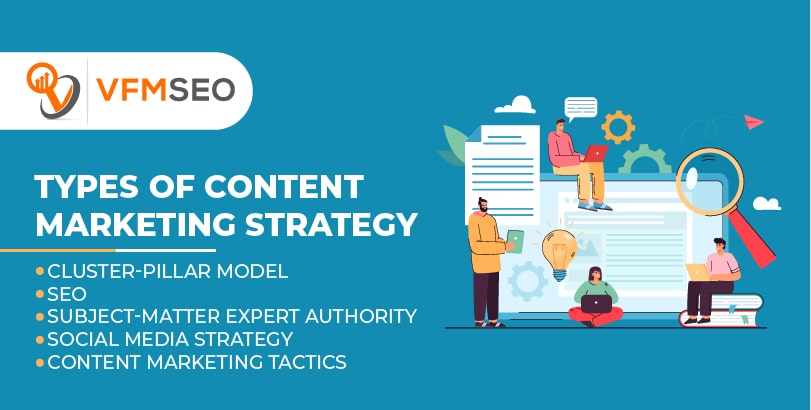
Ways to Build Effective Types of Content Marketing Strategies
Curious to know the ways to build effective types of content marketing strategies? We’ve all witnessed it—when a content marketing strategy clicks on a large scale, building long-lasting opportunities and growth for their business, and engaging new audiences. How did they know? How did they craft a message, funnel it through the proper channels with impactful content, almost as if they knew exactly what would work?
As students of content strategy, we know the end goal of a content marketing strategy is to show how our content development and execution have achieved clear business objectives. But doing so necessitates spending time identifying the most effective ways to connect with our audience.

What does a content strategy look like?
Content strategy needs a lot more than creating and distributing content—even if the content is good. A well-crafted blog or a semi-viral video with 10,000+ views is not how content strategy obtains business objectives for you or your company. The flow of new, incoming traffic is a pleasant boon, a high-five for your marketing team, but it rarely leads to actual results.
Understand your audience in their complete capacity as information gatherers; each has a long history of detecting time-sap, click-bait, unengaging content traps. They know garbage when they see it. And now they value worthwhile content more-so because of those bad happenings.
A good content marketing approach focuses on relevancy and connection with audiences over time and across multiple forms and mediums. The goal is to complete authenticity with your viewers—and there’s no single content strategy that suits every business. Address yours organically, but don’t hesitate to look at different types of content strategies to get you started.

Different Types of Content for Several Types of Audience
Content is the currency of your marketing strategy, and there are hundreds of types of content that your business can utilize to attract customers, expand your audience reach, and convert leads to sales.
You already know that various brands use content across the Internet, and you can build a winning content strategy to build an online presence. Ask yourself these three questions whenever you create content to fill your marketing mix:
- Who: Who are your clients, and what do they look like? What is their age, gender, location, and demographic?
- What: What questions are your customers asking? What are their pain marks, and what solutions are they looking for?
- Where: Where do your customers look for answers and solutions? Do they question Google, or do they look on YouTube, Facebook, or LinkedIn?
- How: How do your customers search for keys and solutions online? Do they use a laptop or phone, and do they look for text answers or pictures?
You will see that some forms of content take longer to produce, and you will have to pay more to outsource. Instead of trying to think of different content types, we put together a comprehensive list of content types and how to use each one throughout the Content Mapping Process.

Types of Content Marketing Strategy
Your content strategy is not limited to any set formula—nor should you understand the below examples to the teeth. Instead, where can you buy soma bras audience awareness, innovation, and playing to your strengths will help form your content marketing strategy and take these examples as starting points.
Cluster-Pillar Model
This type of content marketing strategy makes traffic through related, linked pieces of content. Generally, the central pillar page will act as the catch-all authority on a broad topic; then, multiple “cluster blogs” on related topics will hyperlink to the pillar page. Finally, the pillar page will navigate the public to a website or webpage with even further information.
What’s interesting about this model is that the audience can start at any point of contact and eventually be linked to all the related pages. Doing this gives substance to your content strategy.
SEO
While keywords still play a vital role when it comes to Search Engine Optimization, this strategy of getting your content to the forefront of search engines includes factors like mobile friendliness, content quality, authenticity, and others to assure audiences are being directed to reliable content.
In a similar way that cluster-pillar approaches achieve authenticity through interconnected content, SEO achieves authenticity by earning through search engine algorithms designed to detect helpful content. A cluster-pillar model is an SEO approach, after all.
Subject-Matter Expert Authority
Often, cold complex data wins the day—and many audiences want reliable content that cuts through the rhetoric. So a subject-matter content strategy strips your content to its bare bones: infographics, how-to articles, online instructional manuals, educational tools.
When you have data that gives audiences real-world, pragmatic tools, they’re far more likely to engage and even subscribe to mailing lists or e-newsletters.
Social Media Strategy
A strong presence on social media is hard for businesses to complete without coming across as heavy-handed or invasive. But there are organic techniques to connect with audiences, as long as your social media push isn’t to drive audiences away from social content and into direct marketing of your product.
Businesses that achieve success with social media strategies build their brand through interaction and participation in social media groups and related social content.
Content Marketing Tactics
The front-end—or execution—of your content marketing tactics is calculated, thought out. But one uncertainty lives: how will your audience respond? And if the answer isn’t what you expected, chalk it up as a loss? Wrong. Tactics in content marketing are formed and finished when you’ve created the content and seen the results.
Data analysis is an excellent method for you to learn how to strategize your future content, and creating lets you know more about your audience—and there are tools available to help you engage with this data.
The platform will point out gaps and opportunities to take traffic share, and with one-click SEO-optimized content outlines, you’ll save time in the method.
Conclusion
Good content has been (and always will be) the foundation of a successful marketing strategy. It will drive customers through organic searches and work to turn those leads into paying customers.
Content is also highly controllable. It allows your business to control the storyline and tell your customers why they should love your brand and buy your products.
In the past, marketers were far more limited in their options when it reached to branded content. Nowadays, there are numerous options from which companies can pick and choose from to create their marketing mix that fits best for their target market.

